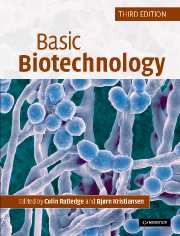Book contents
- Frontmatter
- Contents
- List of contributors
- Preface to the second edition
- Preface to the third edition
- Part I Fundamentals and principles
- Part II Practical applications
- Chapter 12 High-throughput screening and process optimisation
- Chapter 13 The business of biotechnology
- Chapter 14 Amino acids
- Chapter 15 Organic acids
- Chapter 16 Microbial polysaccharides and single cell oils
- Chapter 17 Environmental applications
- Chapter 18 Production of antibiotics by fermentation
- Chapter 19 Strategies of cultivation
- Chapter 20 Enzyme biotechnology
- Chapter 21 Recombinant proteins of high value
- Chapter 22 Insect and mammalian cell culture
- Chapter 23 Plant cell biotechnology
- Chapter 24 Biotransformations
- Chapter 25 Immunochemical applications
- Index
Chapter 15 - Organic acids
Published online by Cambridge University Press: 05 June 2012
- Frontmatter
- Contents
- List of contributors
- Preface to the second edition
- Preface to the third edition
- Part I Fundamentals and principles
- Part II Practical applications
- Chapter 12 High-throughput screening and process optimisation
- Chapter 13 The business of biotechnology
- Chapter 14 Amino acids
- Chapter 15 Organic acids
- Chapter 16 Microbial polysaccharides and single cell oils
- Chapter 17 Environmental applications
- Chapter 18 Production of antibiotics by fermentation
- Chapter 19 Strategies of cultivation
- Chapter 20 Enzyme biotechnology
- Chapter 21 Recombinant proteins of high value
- Chapter 22 Insect and mammalian cell culture
- Chapter 23 Plant cell biotechnology
- Chapter 24 Biotransformations
- Chapter 25 Immunochemical applications
- Index
Summary
Introduction
Various organic acids are accumulated by several eukaryotic and prokaryotic micro-organisms. In anaerobic bacteria, their formation is usually a means by which these organisms regenerate NADH, and their accumulation therefore strictly parallels growth (e.g. lactic acid, propionic acid, etc; see Chapter 2). In aerobic bacteria and fungi, in contrast, the accumulation of organic acids is the result of incomplete substrate oxidation and is usually initiated by an imbalance in some essential nutrients, e.g. mineral ions. Despite the completely different physiological prerequisites for the formation of these products, no distinction will be made between these two types of products in this chapter. The organic acids described below are those that are manufactured in large volumes (see Table 15.1), and marketed as relatively pure chemicals or their salts.
Citric acid
Citric acid (2-hydroxy-propane-1,2,3-tricarboxylic acid; Fig. 15.1) was first discovered as a constituent of lemons, but is today known as an intermediate of the ubiquitous tricarboxylic acid cycle (see p. 31) and therefore occurs in almost every living organism. Originally produced from lemons by an Italian cartel, the discovery of its accumulation by Aspergillus niger (then named Citromyces) in the early 1920s led to a rapid development of a fermentation process that, 15 years later, accounted for more than 95%; of the world's production of citric acid.
Microbial strains and biochemical pathways of citric acid accumulation
Most of today's citric acid is produced by A. niger.
- Type
- Chapter
- Information
- Basic Biotechnology , pp. 359 - 380Publisher: Cambridge University PressPrint publication year: 2006
- 6
- Cited by



